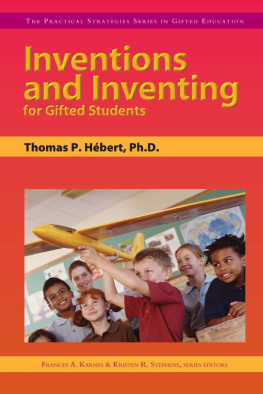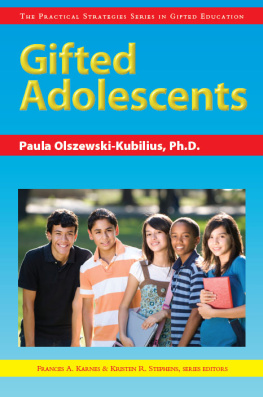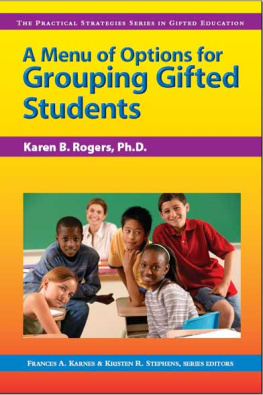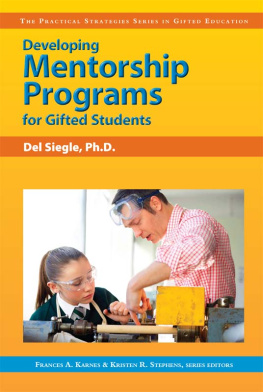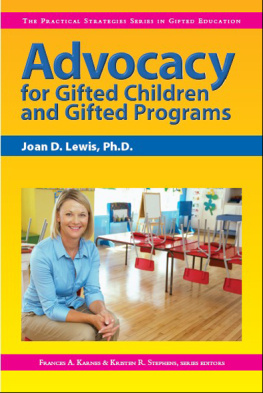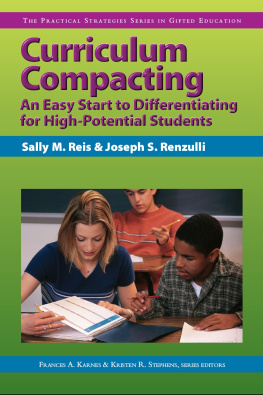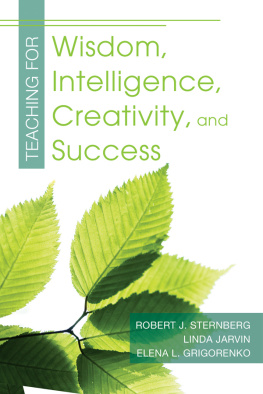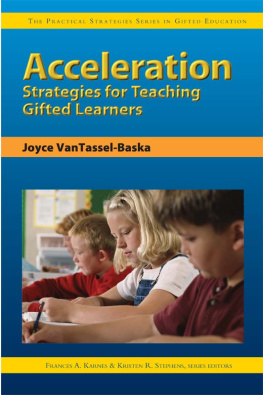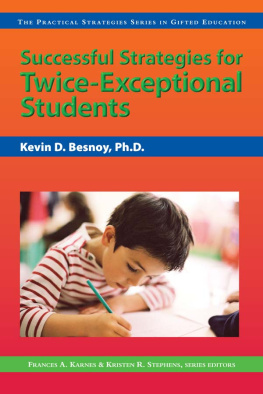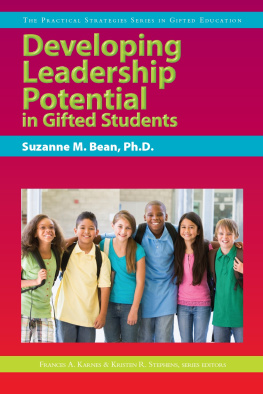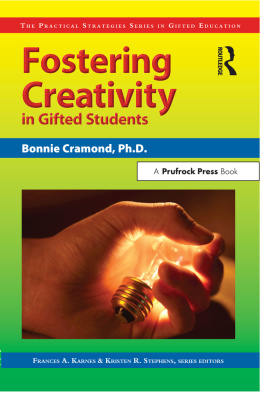THE PRACTICAL STRATEGIES SERIES
IN GIFTED EDUCATION
series editors
FRANCES A. KARNES & KRISTEN R. STEPHENS
Inventions
and Inventing
for Gifted Students
Thomas P. Hbert

P RUFROCK P RESS , I NC .
Copyright 2005 by Frances A. Karnes
and Kristen R. Stephens-Kozak
All rights reserved.
No part of this book may be reproduced, translated, stored in a retrieval system, or transmitted, in any form or by any means, electronic, mechanical, photocopying, microfilming, recording, or otherwise, without written permission from the publisher.
Printed in the United States of America.
ISBN-13: 978-1-59363-763-7
At the time of this books publication, all facts and figures cited are the most current available. All telephone numbers, addresses, and Web site URLs are accurate and active. All publications, organizations, Web sites, and other resources exist as described in the book, and all have been verified. The authors and Prufrock Press, Inc., make no warranty or guarantee concerning the information and materials given out by organizations or content found at Web sites, and we are not responsible for any changes that occur after this books publication. If you find an error, please contact Prufrock Press, Inc. We strongly recommend to parents, teachers, and other adults that you monitor childrens use of the Internet.

Prufrock Press, Inc.
P.O. Box 8813
Waco, Texas 76714-8813
(800) 998-2208
Fax (800) 240-0333
http://www.prufrock.com
Contents
Series Preface
The Practical Strategies Series in Gifted Education offers teachers, counselors, administrators, parents, and other interested parties up-to-date instructional techniques and information on a variety of issues pertinent to the field of gifted education. Each guide addresses a focused topic and is written by scholars with authority on the issue. Several guides have been published. Among the titles are:
- Acceleration Strategies for Teaching Gifted Learners
- Curriculum Compacting: An Easy Start to Differentiating for High-Potential Students
- Enrichment Opportunities for Gifted Learners
- Independent Study for Gifted Learners
- Motivating Gifted Students
- Questioning Strategies for Teaching the Gifted
- Social & Emotional Teaching Strategies
- Using Media & Technology With Gifted Learners
For a current listing of available guides within the series, please contact Prufrock Press at (800) 998-2208 or visit http://www.prufrock.com.
Introduction
Invention is a source of hope that life will be better tomorrow compared to today; invention is the key to solving many of the problems we face.
M. Hertz (1999, p. 101)
During my first year as a teacher of gifted students, I met a young inventor named Jonathan. He arrived in my classroom and proudly announced that he had a great idea for an independent project. He explained to me that, as far back as he could remember, he had watched his father suffer from severe backaches and was concerned about his dad every week when it was time to mow the familys lawn. Jonathan was currently a fourth grader, and as he shared his worries about his father, he claimed that, as a kindergarten student, he had vowed to do something to help his dad.
With this promise to his father in mind, Jonathan decided to address his dads problem through an invention. He announced that he had plans to design a pair of shoes that would incorporate tiny mowers underneath the soles, enabling his father to wear them and simply walk across the familys grass as the tiny lawn mower shoes trimmed the grass. Jonathan began working in my classroom on sophisticated blueprints for his invention. In a short time, he had acquired a collection of used shoes from the teachers in our elementary school. He was completely absorbed in his project as he worked on attaching a tiny lawn mower engine underneath the soles of the wing-tip shoes he had managed to elevate with pieces of lumber.
Jonathans friends were delighted when he presented his final product, Lawn Mower Shoes, and began working on an advertising campaign to convince his neighbors and friends to invest in his new product. While Jonathan was working on his advertisements, the young women in Jonathans fourth-grade class quickly pointed out that his wing-tip prototype was somewhat sexist. As a result, Jonathan proceeded to design the feminine version of the Lawn Mower Shoes. Within a week, he created a womens open-toed, high-heeled sandal that was also equipped with a built-in mower. Jonathan was ready to convince both men and women in his community that Lawn Mower Shoes were the answer to every suburban homeowners drudgery.
Jonathan inspired me as a teacher. His experiences in the classroom helped me realize how much fun young people could have with learning the inventing process while simultaneously developing their creative thinking skills. From then on, teaching inventions became a standard component of my curriculum.
Several years after my work with Jonathan, I taught gifted students in the Department of Defense Dependents Schools in West Germany and enjoyed working with families of the military. Following a unit I taught on inventing, Jack, a highly creative middle school student, won first prize in our classroom Invention Convention with a simple gadget he created to solve a pet peeve he faced quite often.
Jack explained that his family enjoyed dining out in quaint, rustic restaurants in their travels throughout the German countryside. He noted that the tables in these restaurants were often rather wobbly and needed to be steadied. Since Jack did not want to appear rude and trouble the waiters and waitresses, he designed a small block of wood in which he carved four different corners with varying levels of height. He attached rubberized material to the bottom of the block to insure that his gadget would remain in place. With his pocket-sized contraption, Jack and his family could quietly slip his Trusty Table Steadier under a wobbly leg and maintain a steady table, as well as prevent any embarrassment for his American family living overseas.
My students at the University of Alabama enjoyed the same challenge of solving a pet peeve or bug in a course entitled Fostering Creative Expression. Susan, an elementary education major, was involved in clinical field experiences in which she spent time in local elementary schools working with young children. With the winter colds that ran rampant throughout the elementary school, Susan noticed that teachers constantly had to supervise students as they walked to and from the classroom tissue box. As she observed the sniffling students, she came up with a clever idea for an invention with great appeal to elementary educators. She chose to wear a roll of toilet tissue hanging from her neck. She strung the roll of tissue through a colorful, wide ribbon decorated with fancy rhinestones and beads she acquired at a craft store and proudly wore her handy new necklace. As she walked around the elementary classroom throughout the day, she was able to deliver the badly needed tissue to sniffily students at their desks, and soon classroom traffic to the tissue box ceased.
Kristie, a doctoral student at the University of Georgia, confessed to her colleagues in my graduate creativity class that she badly needed a shot of caffeine to jump-start her day. Kristie explained that she needed the caffeine that coffee provided in the morning, yet she wanted to begin her day with a more nutritional alternative. Kristie experienced her Aha! in the middle of the grocery store when she discovered bottles of caffeinated water on the shelf. She promptly purchased several bottles and used it in making her morning orange juice from concentrate. By combining her healthy fruit juice concentrate with the caffeinated water, she had the morning jump-start she wanted and was able to maintain the nutritional nourishment she needed in her hectic graduate-school lifestyle. She called her caffeinated orange juice Orange Jounce, and her advertising campaign included her slogan Orange Jounce: Its Nutrition With an Attitude!
Next page
